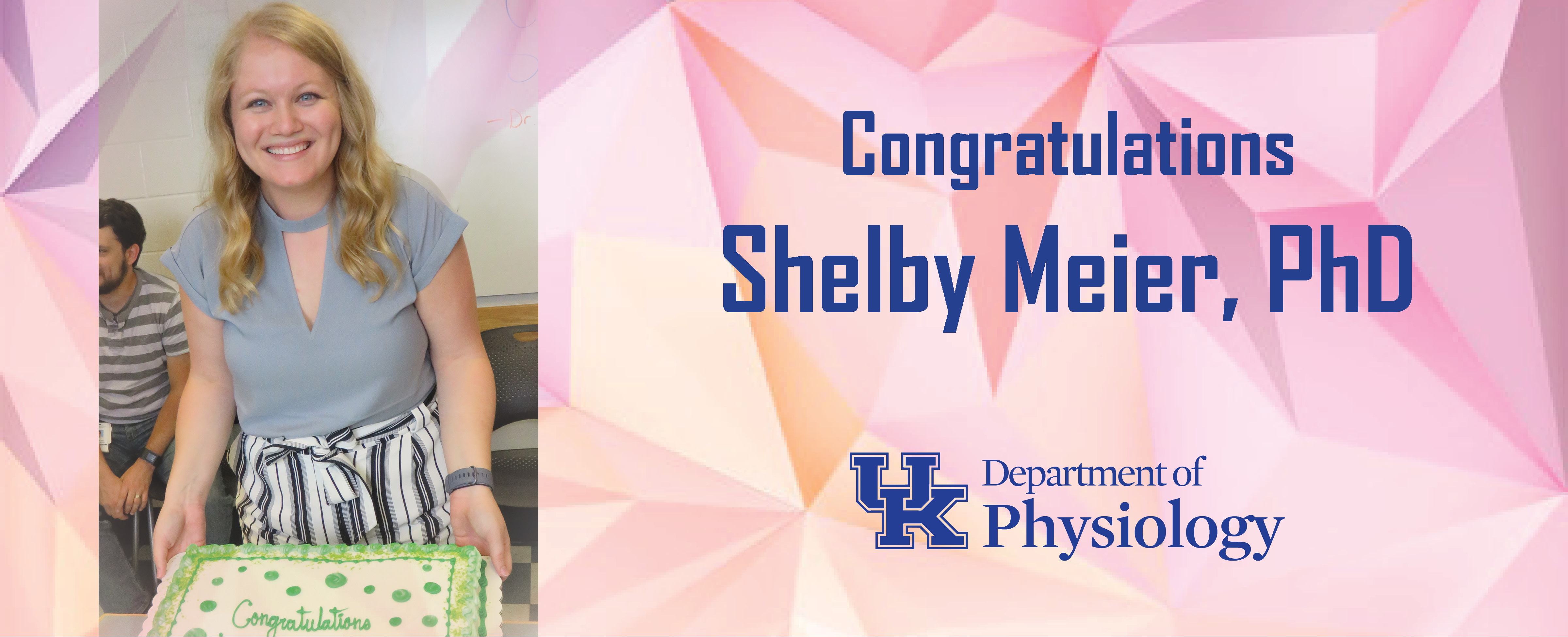Congratulations Shelby Meier, PhD
On Tuesday, July 30, 2019 Shelby Meier successfully defended her dissertation and earned her doctoral degree. Congratulations, Dr. Meier!
“Pathological tau as a cause, and consequence, of cellular dysfunction"
Doctoral Committee
Dr. Joe Abisambra - Department of Physiology, co-chair
Dr. Kathy Saatman - Department of Physiology, co-chair
Dr. Bret Smith - Department of Neuroscience
Dr. Haining Zhu - Department of Molecular & Cellular Biochemistry
Dr. Dave Powell - Department of Neuroscience
Outside Examiner - Dr. Adam Bachstetter - Department of Neuroscience
Abstract of Dissertation
Tauopathies are a group of neurodegenerative diseases characterized by the abnormal deposition of the protein tau, a microtubule stabilizing protein. Under normal physiological conditions tau is a highly soluble protein that is not prone to aggregation. In disease states alterations to tau lead to enhanced fibril formation and aggregation, eventually forming neurofibrillary tangles (NFTs). The exact cause for NFT deposition is unknown, but increased post-translational modifications and mutations to the tau gene can increase tangle formation.
Tauopathic brains are stuck in a detrimental cycle, with cellular dysfunction contributing to the development of tau pathology and the development of tau pathology contributing to cellular dysfunction. The exact mechanisms by which each part of the cycle contributes to the other are still being explored. To investigate the unique contributions of each part of this cycle we utilized two separate models of tauopathy: one chronic and one acute. Overall this project provides novel insight into the role of pathological tau as both a cause, and a consequence, of cellular dysfunction.
To understand how development of tau pathology contributes to cellular dysfunction we studied chronic disease models. Using human brain tissue we found that under normal conditions tau associates with ribosomes but that this interaction is enhanced in Alzheimer’s disease brains. We then used in vitro and in vivo models of tauopathy to show that this association causes a decrease in protein synthesis. Finally, we show that wild type tau and mutant tau reduce protein translation to similar levels.
To understand how general cellular dysfunction contributes to development of pathology we used an acute model of tauopathy through traumatic brain injury (TBI). We injured rTg4510 tau transgenic mice at different ages to investigate the effect of TBI on tau fibrillization (2 month old) and the effect of TBI on tau already in NFTs (4.5 month old). In 2 month old mice, we found that tau hyperphosphorylation was decreased at 24 hours and increased at 7 days post injury, and that tau oligomerization was decreased at 24 hours post injury. We also found that tau fibrillization was not increased after 24 hours or 7 days post injury. In 4.5 month old mice, we found that TBI did not increase or decrease tangle counts in the brain, but we did qualitatively observe decreased variability within groups.
Acknowledgements
In thinking about my time in graduate school, one phrase keeps coming to mind: “It takes a village.” There are multiple villages of people that helped get me to where I am today, and I’m going to try my best to convey my gratitude for them all.
To my family, thank you for supporting me throughout my education. From my first day of kindergarten until today, you’ve all encouraged me to never settle for anything less than my absolute best. Thank you for listening patiently to my frustrations over the past 8 years of higher education and always having my best interests at heart. I love you all! To Grant, I know you know how thankful I am for you but I’m just going to keep saying it anyway. Thank you for being my rock and for always telling me what I need to hear (whether I like it or not). I love you! I got lucky in having two academic families: the department of Physiology (PGY) and Sanders-Brown Center on Aging (SBCOA). Thank you to everyone in PGY that has shared in a laugh or offered support throughout the past 4 years (plus a special thank you to Andrew and Tanya for Moe’s and planning the best holiday parties in Lexington). To Sanders-Brown Center on Aging, thank you for the unwavering support and kindness. I’m incredibly grateful for the opportunity to have worked alongside all of you. To my fellow graduate students, thank you all for being the absolute best sounding boards, therapists, lunch partners, drinking buddies, friends, and just all around great people. Ryan, I don’t know how I would have survived the past four years without all the memes and pitch-black humor. Also, thanks for forgiving me for always forgetting to invite you to lunch. Laura and Brooke, you two are absolute rays of joy and sunshine. Thank you for always putting a smile on my face! Michael, you’ve been number one in my book since the very beginning. Thank you (and Molly) for being the friend(s) that became family. To Sarah Cornett (aka BAE #1) thank you for being the most incredible role model and friend I could ask for. You always take the time to listen and encourage me, despite the fact that talking about science makes you want to claw your eyes out. To every single person that I didn’t mention here but that has encouraged me, made me smile, offered advice, and supported me over the past four years THANK YOU!
